#Heinrich Wölfflin
Text
We get it, Stefania, you read Heinrich Wölfflin's Prologomena to a Psychology of Architecture

#stefania tag#korzenie tag#I love her so much she made her thesis and another guy's thesis into a novel
2 notes
·
View notes
Text


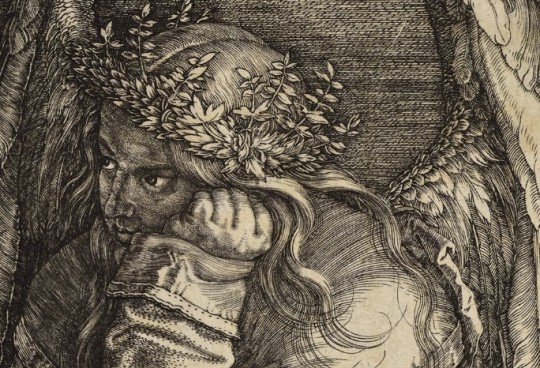
Melencolia I (1514) and details - Albrecht Dürer
Die Melancholie (1514). – Ein geflügeltes Weib, das auf einer Stufe an der Mauer sitzt, ganz tief am Boden, ganz schwer, wie jemand, der nicht bald wieder aufzustehen gedenkt. Der Kopf ruht aus dem untergestützten Arm mit der Hand, die zur Faust geschlossen ist. In der andern Hand hält sie einen Zirkel, aber nur mechanisch: sie macht nichts damit. Die Kugel, die zum Zirkel gehört, rollt am Boden. Das Buch auf dem Schoß bleibt geschlossen. Die Haare fallen in wirren Strähnen, trotz dem zierlichen Kränzchen, und düster blicken die Augen aus dem schattendunklen Antlitz. Wohin geht der Blick? Auf den großen Block? Oder nicht eher darüber hinweg ins Leere? Nur die Augen wandern, der Kopf folgt nicht der Blickrichtung. Alles ist Müde, Dumpfheit, Regungslosigkeit.
Aber ringsherum ist's lebendig. Ein Chaos von Dingen. Der geometrische Block steht da, groß, fast drohend; unheimlich, weil es aussieht, als ob er fallen wollte. Ein halbverhungerter Hund liegt am Boden. Die Kugel. Und daneben eine Menge Werkzeuge. Hobel, Säge, Lineal, Nägel, Zange – alles ungenützt, unordentlich zerstreut.
Was soll das heißen? Als Erklärung steht oben, den Flügeln einer Fledermaus eingeschrieben, das Wort: MELENCOLIA I.
Heinrich Wölfflin. Die Kunst Albrecht Dürers (1905)
#dürer#albrecht dürer#melencolia I#melencolia#Melancholie#kunst#gravur#engraving#texts about art#bildbeschreibung#sprache und kunst#verbildlichung / verschriftlichung von mir beim these schreiben#ugh#melancholia
6 notes
·
View notes
Text

Forms acquire meaning for us only because we recognize in them the expression of a sentient (fühlend) soul. Spontaneously, we animate (beseelen) every object
- Heinrich Wölfflin
magazine doodle by J.J.
#artists on tumblr#artist's studio#drawing#sketchoftheday#illustration#sketchbook#doodles#ink and watercolor#illustrations
3 notes
·
View notes
Text
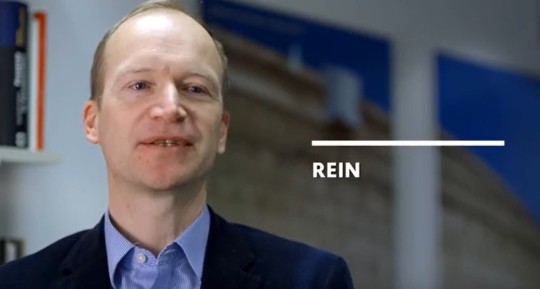

Entscheidungszwang
1.
Reinhard Müller ist das, was früher mal Herausgeber der FAZ waren. Er ist nämlich bereit, einen Leitartikel zu schreiben, nachdem ihm jemand in der Ubahn angerempelt hat. Jeder müsse sich entscheiden, das ist eine seiner These, woran der eine oder andere schon merken kann, dass er in Deutschland ausgebilderter (sic!) Jurist ist, da lehrt man solche Thesen.
Ich glaube nicht an Entscheidungszwänge, habe es aber lange genug versucht. Man kann Differenz auch anders operationalisieren als durch die Technik, die nicht nur Entscheidung genannt wird, sondern noch dazu durch einen weiten Apparat gelehrt wird und zum Instituieren gehört. Es gibt Entscheidungszwänge, es kann gut und hilfreich sein, sich zu entscheiden. Dass ich nicht daran glaube heißt nur, dass ich dem Entscheidungszwang kein Eckchen, auch keine Couchecke in der großen Referenz reserviere. Das Gesetz ist nicht dezisionistisch, sonst wäre es zu kurz gegriffen. Meine These ist, dass man zu sehr auf Entscheidungen und Entscheidungszwänge fixiert sein kann und dadurch andere Techniken vernachlässigt. Jede Doppelmoral liefert Möglichkeiten mit, nicht zu entscheiden. Rom hat dafür nicht nur Moralreproduktion oder Moralverdopplung, sondern auch Architekturen entwickelt, nicht nur den Beichtstuhl. Stadtplanung ist auch hilfreich, dann kann man mal da, mal dort hingehen.
2.
Müller hat die These vom Entscheidungszwang in Zusammenhang mit einer Nachrichtenwelle zu Mesut Özil noch einmal vertreten, nachdem Özil sich wohl zu einer Nähe zu den grauen Wölfen bekannt hat. Er ist zumindest mit einem Tattoo, einem Nachbild der ost- und weströmischen notitia dignitatum, mit einer Art coat of arms, einem in die Haut gestochenen Wappenschild fotografiert worden und das Foto ist durch die Netzwerke gewandert.

Nun gibt es sowohl im übertragenen als auch im nicht-übertragenen Sinn auch graue Wölfe in Deutschland. Das Wappenschild auf der Brust vom Özil ist den grauen Wölfen verbunden, in dem Fall ist eine Gruppe gemeint, die mit rechtsextremen, faschistischen und antisemitischen Positionen verbunden wird. Solche Positionen und ihre Signale gibt es auch in Deutschland, das kommt bei deutschen Staatsbürgern durchaus mal vor, auch in den höchsten Kreisen. Es könnte die Meinungsfreiheit stärken, zumindest, solange es sie nicht schwächt. Wappenschilder haben ein Nachteil: Eine Menge von Leuten behaupten zu wissen, was sie bedeuten und hauen sich deswegen auch gerne die Köpfe ein. Im Fall Özil schrieben auch Leute, die nun wirklich nicht jeden Tag an Özil denken, man könne ihn jetzt vergessen. Der sogenannte Fanforscher Harald Lange, nicht zuständig für Erinnerungspflege, sondern eher für forsche Fans, schrieb, man könne Özil nun getrost vergessen.
Das ist übrigens oft so, das gerade die Leute einem sagen, man hätte ihnen einen Grund für die Abwendung gegeben, die einem ohnehin nicht zugeneigt sind. Aber gerade bei den Wappenbildern, zu denen diese Tattoo noch gehört, liegt vielleicht nahe, dass daran oft Gespräche und Reaktionen anschließen, in denen nahe alle Beteiligten schon so derartig für alles gewappnet sind, dass man auch keine Fragen mehr stellen muss.
3
Müller, der gegen die doppelte Staatsbürgerschaft ist und vermutlich die Entscheidung mit dem Effekt einer Reinheit assoziiert (nämlich dem Effekt, dass das Staatsbürger hervorbringe, deren Beziehung zum Staat geklärt und nicht mehr doppelbödig sei), hat die These vom Entscheidungszwang in einem Zusammenhang vertreten, wo die Entscheidung nichts entscheidet.
Das könnte öfters mal der Fall sein. Nicht nur, dass der Unterschied, wie Heinrich Wölfflin beschreibt, zwischen Italien und Deutschland sowohl in Italien als auch in Deutschland vorkommt. Der Unterschied zwischen Deutschland und er Türkei kommt auch in Deutschland und der Türkei vor. Özil ist nicht nur ein Meister der Fußballs, der ist, weil er schon so ein Meister ist, auch ein Meister der Polarität. Seine berühmten Hinweise zum Sieg und Deutschtum sowie zur Niederlage und Türkischtum haben etwas davon den Punkt gebracht, bringen das auf den Punkt. Dass Özil so etwas kränkt, das verstehe ich, hoffe, dass er mit Kränkung gut umgehen kann und nicht mehr gekränkt wird. Die grauen Wölfe stehen vielfach unter Beobachtung, auch des Verfassungsschutzes und Reinhard Müllers.
Der große Vorteil und die große Lehre einer Migrationsgesellschaft basiert auf der Lehre, dass alles das, was hier vorkommt, auch woanders vorkommt, nur in anderen Reihenfolgen, an anderen Stellen, Schichten und Muster. Idioten gibt es viele, am Rheine und am Nile. An der Ruhr sagt man darum: woanders ist auch Scheiße. Eine reine Rechtslehre verdient Kritik nicht deswegen, weil man in Wirklichkeit nichts reinigen sollte oder weil in Wirklichkeit das Recht rein sei. Sie verdient Kritik, wenn sie in der Wahrnehmung von Kreuzungen schwächelt. In seinem Buch zur Verfassungsgeschichte und Verfassungstheorie der Moderne hat sich Bruno Latour deswegen nicht darauf versteift und nicht daran aufgehalten, die Moderne als etwas zu beschreiben, was es in Wirklichkeit nicht gab. Aus dem Buch kann man die Lehre mitnehmen, Reinigung auch als Verfahren der Kreuzung zu beschreiben. Kreuzungen wahrzunehmen soll das Vermögen, Distanz schaffen zu können, mit Normativität umzugehen und sich für das Gute sowie gegen das Böse zu entscheiden nicht schwächen. Gerade darum reserviere ich dem Entscheidungszwang nicht einmal ein Sitzecke in der großen Referenz. Wenn man Probleme mit den grauen Wölften teilt, und das tut man unabhängig davon, ob man für oder gegen die grauen Wölfe ist, ist es hilfreich so viel wie möglich wahrnehmen zu können.
3 notes
·
View notes
Text
Palladio - Giulio Argán
Investigación individual
Fichas: Otras Obras y Autores
Francesco Milizia
Fue un italiano conocido como teórico de la arquitectura y tratadista durante alrededor de los años 1730 y 1790. Es considerada uno de los principales autores que teorizó el neoclasicismo en su primera fase a través de sus escritos. Es conocido principalmente por sus tratados estético-críticos, entre los que destacan: Sobre el arte de ver en las bellas artes (1781) y Diccionario de las bellas artes del dibujo (1797). Abogó por imitar las obras maestras del arte griego antiguo, sobre la base de que los artistas de esa época habían podido inspirarse en una naturaleza y una sociedad aún no corruptas.

Vidas de arquitectos
Consta de cuatro libros: el primero es un resumen de la arquitectura y el segundo, el tercero y el cuarto fueron la parte histórico-biográfica de la obra, esta última subdividida a su vez en arquitectos antiguos (desde la decadencia de la arquitectura hasta su restablecimiento, es decir, siglo IV al siglo XV) y arquitectos del «restablecimiento» (arquitectura de alrededor del siglo XV, hasta el XVIII)

Winckelmann
Fue un alemán que destacó por ser Arqueólogo e historiador de arte. Es considerado el pionero de la arqueología moderna y del gusto neoclásico. En el año 1755 publicó su primera obra, un ensayo titulado Gedanken über die Nachahmung der griechischen Werke in der Malerei und Bildhauerkunst (Reflexiones sobre la imitación de las obras griegas en la pintura y la escultura). Se considera que fue el que inicio la arqueología como la conocemos hoy en día
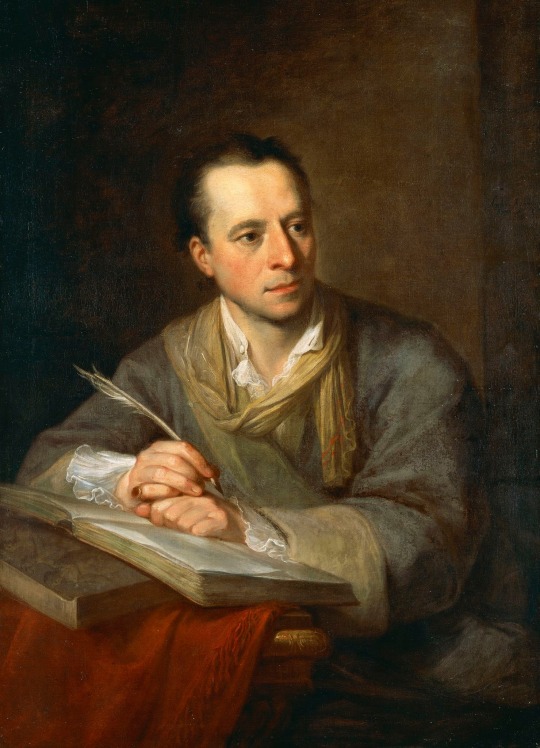
Mengs
Fue un pintor y tratadista checo, el más destacado del primer neoclasicismo. Su etapa de formación no sólo se orientó a las técnicas sino a la teoría del arte, que estaba en sus inicios como ciencia, abanderada por Johann Joachim Winckelmann, de quien fue alumno. En 1761 pintó, en el techo de la Villa Albani, en Roma, el fresco de El Parnaso, que se convirtió en una especie de manifiesto del neoclasicismo por su evidente empleo de soluciones tomadas de los maestros del Renacimiento, en particular de Rafael.
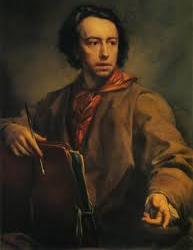
Wölflin
Fue un historiador de arte Suizo. fue catedrático en las universidades de Basilea, Berlín, Munich y Zurich, y uno de los estudiosos más influyentes en la moderna historia del arte. Además, conocido como uno de los máximos representantes del formalismo. Algunas de sus obras más destacada fueron Conceptos fundamentales para la historia del arte (1915), Renacimiento y Barroco (1888) y El arte clásico (1899).

León Battista Alberti
Arquitecto, teórico del arte y escritor italiano, fue además un peta, filósofo y organista. Estudio las leyes de la perspectiva que había desarrollado Brunelleschi. En su tratado Della Pittura (1436), explica estas leyes que serían fundamentales para la pintura de su época. Fue, con Leonardo da Vinci, una de las figuras más representativas del ideal del hombre del Renacimiento

Paolo Veronese
Fue un Pintor italiano. Uno de los tres grandes maestros de la pintura veneciana en la segunda mitad del siglo XVI, junto con Tiziano y Tintoretto. Se concidera que fue la figura principal del Manierismo veneciano y casi podríamos considerarlo un artista prebarroco. Era gran amigo de Palladio y otros grandes arquitectos de la época, por lo que se fijaba en el entorno donde reposarían su pinturas. Esto lo hace precursor de la pintura decorativa barroca.

Referencias Bibliográficas
Anton Raphael Mengs - 87 obras de arte - pintura. (s. f.). www.wikiart.org. https://www.wikiart.org/es/anton-raphael-mengs
Biografia de Anton Raphael Mengs. (s. f.). https://www.biografiasyvidas.com/biografia/m/mengs.htm
Biografia de Heinrich Wölfflin. (s. f.). https://www.biografiasyvidas.com/biografia/w/wolfflin.htm
Biografia de Johann Joachim Winckelmann. (s. f.). https://www.biografiasyvidas.com/biografia/w/winckelmann.htm
Biografia de Leon Battista Alberti. (s. f.). https://www.biografiasyvidas.com/biografia/a/alberti_leon.htm
De Enciclopedias, R. (s. f.). Las vidas de los más célebres arquitectos de todas las naciones y de todo tiempo, Francesco Milizia | Crítica de libros. https://www.criticadelibros.com/sin-clasificar/las-vidas-de-los-mas-celebres-arquitectos-de-todas-las-naciones-y-de-todo-tiempo-francesco-milizia/
De La Oliva Estrella Moreno Y Otros, V. M. M. E. R. C. (s. f.). Biografía de Johann Joachim Winckelmann (Su vida, historia, bio resumida). https://www.buscabiografias.com/biografia/verDetalle/5788/Johann%20Joachim%20Winckelmann
De La Oliva Estrella Moreno Y Otros, V. M. M. E. R. C. (s. f.). Biografía de Leon Battista Alberti (Su vida, historia, bio resumida). https://www.buscabiografias.com/biografia/verDetalle/6528/Leon%20Battista%20Alberti
Francesco Milizia - frwiki.wiki. (s. f.). https://es.frwiki.wiki/wiki/Francesco_Milizia
MCNBiografias.com. (s. f.). Milizia, Francesco (1725-1798). » MCNBiografias.com. https://www.mcnbiografias.com/app-bio/do/show?key=milizia-francesco
Mengs, Anton Rafael - Colección. (s. f.). Museo del Prado. https://www.museodelprado.es/coleccion/artista/mengs-anton-rafael/bcd5ee4e-bcc3-472b-a832-a4800279e0e0
Montejo, L. (2023, 17 mayo). Los conceptos fundamentales del arte según Heinrich Wölfflin. Hojas de acanto. https://www.hojasdeacanto.com/post/conceptos-fundamentales-de-la-historia-del-arte
Paolo Veronese. (1528). HA! https://historia-arte.com/artistas/paolo-veronese
0 notes
Photo
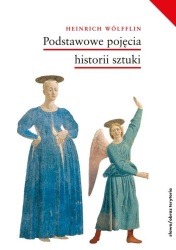
Heinrich Wölfflin
„Podstawowe pojęcia historii sztuki”
0 notes
Text
INFORME
Giulio Carlo Argán, nacido el 17 de mayo en 1909 en Turín, fue un historiador y crítico de arte italiano, pertenece a la generación de jóvenes que se vio alimentada tanto por el pensamiento de Groce como por el de R. Giolli y Carlo Ludovico Ragghianti, trabajo de inspector de los museos del estado y profesor de historia del arte en las universidades de Palermo y Roma, en esta última ciudad fue alcalde entre 1976 y 1979, desarrollando después de la segunda guerra mundial una intensa actividad en la promoción y difusión del arte contemporáneo.
Apoya el movimiento moderno, inclinándose por el liberalismo artístico y dando a conocer sus características en la crítica española del momento, como autor teórico escribe numerosos libros que tratan sobre diversas épocas de la arquitectura, desde el renacimiento de Gropius y la Bauhaus, pasando por el Barroco Italiano, desde una perspectiva marxista considera el arte de cualquier época como el desarrollo de la materia producido por el trabajo, en la fase post histórica que se abre tras el desarrollo y agotamiento de la modernidad entiende la cultura actual como una muerte del arte.
Entre sus obras se encuentran.
−El arte moderno (1970)
−Storia dell´arte italiana (1968)
−Historia del arte como historia de la ciudad (1983)
−Walter Gropius y la Bauhaus (1957)
−Guida alla sto dell´arte (1992)
−Arte e crítica de arte (1984)
−Michelangelo Architect (1987)
−Renacimiento y Barroco (1987)
−Capogrossi.
Andrea Palladio, fue un importante arquitecto italiano en la república de Venecia, y está considerado el mejor arquitecto italiano del Renacimiento y de toda la historia, un apasionado de la simetría y las proporciones.
Las ideas de Andrea Palladio dieron origen al palladianismo y posteriormente al neopalladianismo, posicionando definitivamente al arquitecto como una de las figuras más influyentes de la historia de la arquitectura en el occidente. La obra de Andrea Palladio deriva de la arquitectura clásica grecorromana, admirada por su equilibrio y simetría.
Trabajó fundamentalmente en la ciudad de Vicenza y sus alrededores, y también en la misma Venecia. Construyó decenas de obras para las familias pudientes de la República de Venecia, desde gloriosas residencias privadas hasta edificios públicos que están en la Lista del Patrimonio de la Humanidad de la UNESCO.
Obras importantes de Palladio
-Palazzo Chiericati, Vicenza
-Villa Trissino, Melego do Sarego
-Villa Chiericati, vancimuglio.
-Villa Cornade. Piombino dese
-Arco Bollani
-Villa Repeta
-Villa Foscari
-Villa Bárbaro
-Palazzo del Carpitaniato
-Villa Badoer
Francesco Milizia
Francesco Milizia fue un teórico de la arquitectura y tratadista de arte italiano nacido en Oria, Brindisi, en 1725 y fallecido en Roma en 1798.
Defensor del gusto neoclásico. Su pensamiento como crítico de arte quedó expuesto en las obras: Memoria de los arquitectos antiguos y modernos 1768, Principios de la arquitectura civil 1781, y Arte de saber ver en las Bellas Artes del diseño 1781.
Sus ideas y teorías fueron puestas en práctica en las ciudades del s. XIX. Entre sus preocupaciones urbanas estaban: la higiene, las grandes plazas, edificios públicos desahogados (principalmente las iglesias) y los espacios verdes integrados en la malla urbana.
Heinrich Wölfflin
(Winterthur, Suiza; 21 de junio de 1864-Zúrich, 19 de julio de 1945) fue un famoso teórico y crítico de arte suizo,[1] profesor en Basilea, Berlín y Múnich, considerado como uno de los mejores historiadores de arte de toda Europa.
Obras
Prolegomena zu einer Psycologie der Architektur (1886).
Glosario
Neoclásico
Estilo arquitectónico que reacciona contra los efectos decorativos del barroco y el rococó. Gusto por la sencillez, con predominio de lo arquitectónico sobre lo decorativo.
Paralelismo
Es la reiteración de una misma estructura para lograr un efecto de ritmo.
Luminosidad
Es una propiedad de los colores. Ella da una indicación sobre el aspecto luminoso del color. Este término se asocia a veces con el concepto de valor, luminancia, luz.
Antítesis
Es una relación de oposición entre preposiciones, son dos juicios que se contraponen el uno al otro.
Barroco
La arquitectura barroca es un período de la historia de la arquitectura que vino precedida del Renacimiento y del manierismo; se generó en Roma a principios del siglo XVII y se extendió hasta mediados del siglo XVIII por los estados absolutistas europeos.
Yuxtaposición
Es la unión de dos o más elementos u espacios que mantienen sus cualidades inherentes a su conformación, y no generan un tercer espacio con características propias.
Subversión
Aquello que se propone a subvertir un orden establecido.
Escorzo
Representación de una figura situada oblicua o perpendicularmente al plano del papel o lienzo sobre el que se pinta.
Cornisa
Es la parte superior y más saliente de la fachada de una edificación. Tiene como función principal evitar que el agua de lluvia incida directamente sobre el muro o se deslice por el mismo.
Pictórica
Que es adecuado para ser tratado como arte al ser retratado en una pintura.
Siento que el autor busca comunicar el inmenso control del espacio que consiguió amaestrar Palladio, que cada uno de sus espacios estaba meticulosamente planteado para resolver un problema distinto. Que ya sea una columna o una cornisa, cada uno de los elementos de sus obras están pensados con una yuxtaposición tanto estructural como artística.
Concluyendo que es un arquitecto al que no se puede encasillar en lo que se entiende como clásico.
Giulio Carlo Argan, el cual en su escrito nos deja visible que para él Palladio no debería considerarse totalmente un arquitecto clásico debido a que éste no gozaba de una clara conciencia de los límites de sus gustos escapando a un plano sin una definición exacta gracias a la creatividad que se arraigaba en él, impidiéndole apegarse a reglas preestablecidas
El caso de Giulio Carlo Argan es único, ya que es un ferviente crítico al clasisimo y esto se puede ver a través de sus escrito, en el texto, se hacen constantes comparaciones a otros autores y arquitectos los cuales tienen visiones distintas sobre el personaje el cual se estudia, yo creo que el texto, como crítica no es comparable, puesto es algo muy personal de Carlo Argan el cuel en base a su percepción nos da a conocer su punto sobre lo clásico y la participación de Palladio en ella.
Podemos ver una comparación muy clara entre Palladio y otros arquitectos, ya que se menciona el libro “Vidas de arquitectos” por Milizia en 1768; donde salen a relucir las nuevas ideas de Wincklemannn y Mengs, explicando que “ellos habían alcanzado la razón del arte, la pura belleza, coherencia bella de partes bellas, representación absoluta del espacio a través del valor constructivo del relieve plástico”. Y los llama “filósofos” mientras que a Palladio lo define como “extravagante”. Siendo considerado como absurdo, Palladio se opone a lo clásico dando menos valor es este criterio.
0 notes
Text
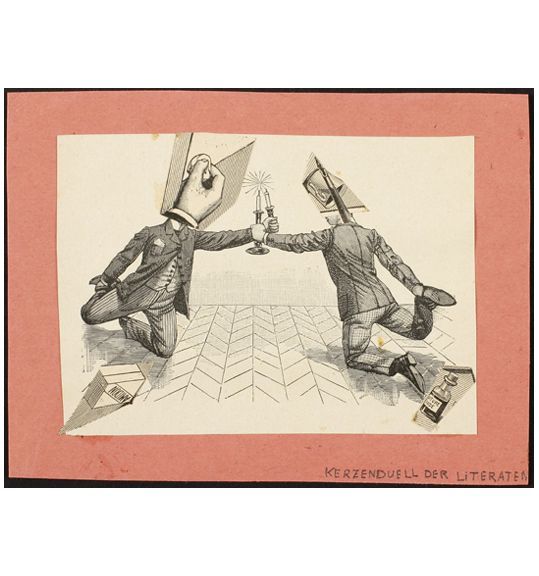
Franz Roh - (German, 1890 – 1965)
"Kerzenduell Der Literaten - 1930
German art historian, critic, collagist and photographer who not only defined the European avant-garde between the two World Wars, but who – as both critic and artist – influenced the collective trends seen in much photo-based work today.
Called the “Nero of Criticism” by friends ��� notably Willi Baumeister, George Grosz, László Moholy-Nagy and Kurt Schwitters – Roh is well known for his landmark publication, Post-Expressionism–Magic Realism: Problems of Recent European Painting, an ambitious attempt to codify the art historical paradign of his mentor, Heinrich Wölfflin, with a complete roll-call of the new objective painters. Roh coined the term “magic realism” to emphasize the return of these painters to realism after a decade or more of abstraction in art. “Tih the word ‘magic’ as opposed to ‘mystic’, I wish to indicate that the nystery does not descend to the represented world, but rather hides and palpitates behind it…” Because objects had been lost to abstraction and were now being made newly available to the sense of the beholder.
ubugallery.com
1 note
·
View note
Quote
Είναι αλήθεια ό,τι βλέπουμε μόνο ό,τι ζητούμε, αλλά και ζητούμε μόνο ό,τι μπορούμε να ιδούμε.
Heinrich Wölfflin, Βασικές έννοιες της Ιστορίας της Τέχνης
2 notes
·
View notes
Photo
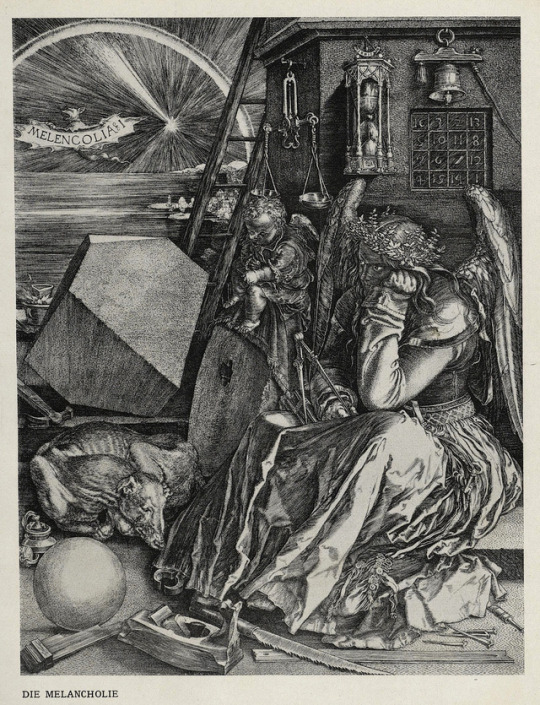
Albrecht Dürer (1471-1528), 'Melencolia I' (1514), ''Die Kunst Albrecht Dürers'' by Heinrich Wölfflin, 1943
Source
“Dürer's Melencolia I is one of three large prints of 1513 and 1514 known as his Meisterstiche (master engravings). The other two are Knight, Death, and the Devil and Saint Jerome in His Study. The three are in no way a series, but they do correspond to the three kinds of virtue in medieval scholasticism--moral, theological, and intellectual--and they embody the complexity of Dürer's thought and that of his age.
Melencolia I is a depiction of the intellectual situation of the artist and is thus, by extension, a spiritual self-portrait of Dürer. In medieval philosophy each individual was thought to be dominated by one of the four humors; melancholy, associated with glack gall, was the least desirable of the four, and melancholics were considered the most likely to succumb to insanity. Renaissance thought, however, also linked melancholy with creative genius; thus, at the same time that this idea changed the status of this humor, it made the self-conscious artist aware that his gift came with terrible risks.
The winged personification of Melancholy, seated dejectedly with her head resting on her hand, holds a caliper and is surrounded by other tools associated with geometry, the one of the seven liberal arts that underlies artistic creation--and the one through which Dürer, probably more than most artists, hoped to approach perfection in his own work. An influential treatise, the De Occulta Philosophia of Cornelius Agrippa of Nettesheim, almost certainly known to Dürer, probably holds the explanation for the number I in the title: creativity in the arts was the realm of the imagination, considered the first and lowest in the hierarchy of the three categories of genius. The next was the realm of reason, and the highest the realm of spirit. It is ironic that this image of the artist paralyzed and powerless exemplifies Dürer's own artistic power at its superlative height.” (Source)
#albrecht dürer#german artist#german painter#melencolia i#Die Kunst Albrecht Dürers#heinrich wölfflin#engraving#the met#the metropolitan museum of art
55 notes
·
View notes
Photo
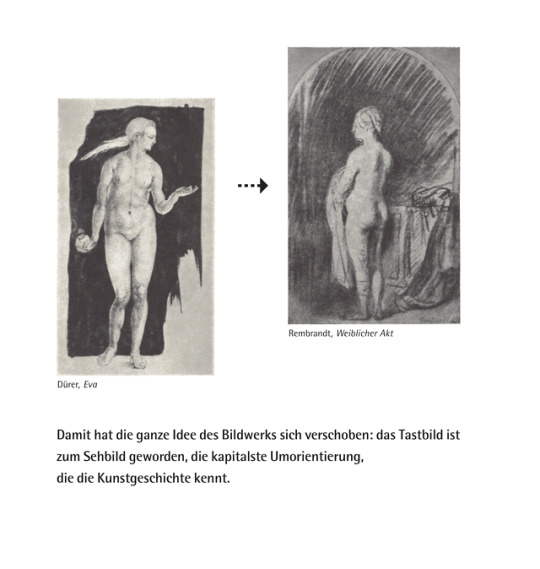
xform
heinrich wölfflin’s words from his fundamental Kunstgeschichtliche Grundbegriffe, chapter 1 «Das Lineare und das Malerische» [benno schwabe & co, basel, 1948, p34]. set in rotis semi sans—vide ‹weighty words›.
illustrations: ibid., p46-7.
1 note
·
View note
Photo
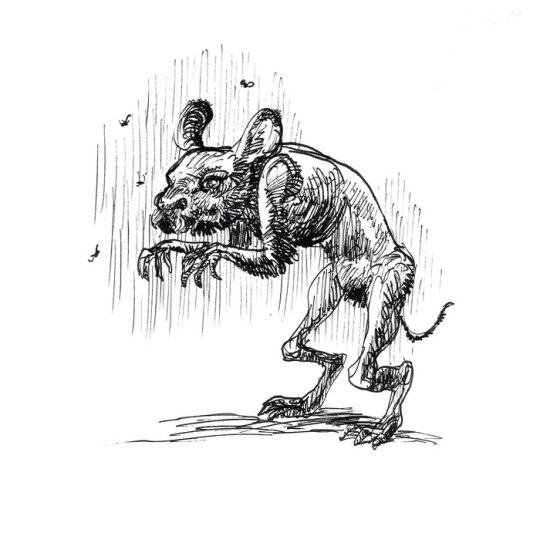
Okay, so I saw this video on German artist Heinrich Kley on Youtube. Then I was fascinated enough to buy an old art book with his pen drawings in it. And then I was fascinated enough to unpack my own ink pens, and to try and find out more about his drawing technique.
What challenges me most is that he seems to work less “cleanly” than I’m used to. Or in the terms of art historian Heinrich Wölfflin, he draws rather “painterly” than “linearly”: With less interest in the single line, and more interest in the overall distribution of light and dark.
Oh, and why this is kind of a humanoid rat? I can’t really say. I was focused on drawing “painterly” here. Afterwards I thought this could be a rat from “Dark Souls”.
#penandink#ink#inkdrawing#illustration#linedrawing#heinrich kley#pendrawing#traditional drawing#traditional art#artists on tumblr#drawing study#rat#hatching#wererat#jonas von grumbkow
13 notes
·
View notes
Text
Art History Reader: Gestalt Theory

Gustav Klimt, Death and Life, 1908, Leopold Museum.
In any fictional crime show, the detective walks into a scene full of chaos. Instead of being overwhelmed, the detective investigates and catches specific small details to discover what occurred. Generally speaking, they are creating order and organization out of specific elements amongst the disordered scene using Gestalt principles, just like artists and designers do. The Gestalt is based in the mind rather than simply what is physically in front of us. Art viewers and critics are just detectives for works of art, which can sometimes be more absurd (or even derivative) than a crime scene.
The Germans have long influenced the way we view art. From dark Gothic architecture and reproduction using the printing press, to the functionality of the Bauhaus and concrete designs of Brutalism, German art reigns. The modern discipline of art history and theory is built on the thoughts of German philosophers and theorists, like Johann Joachim Winckelmann’s development of aesthetics and Heinrich Wölfflin’s understanding of formal analysis. Gestalt theory similarly originated in Germany. Within art theory, the practice that explains how we think about art and its functions, the psychology of the Gestalt helps us understand how our brain interprets art.
Focusing primarily on composition, the term gestalt is a German word meaning “unified whole.” In the 1920s, while Sigmund Freud was psychoanalyzing our deep desires, German psychologists Max Wetheimer, Kurt Koffka, and Wolfegang Kohler were developing Gestalt psychology. The group wanted to better understand how our brain interprets the visual chaos of our world. The principles they developed explained how we visualize specific elements of our world, and how our minds find order and organization. This is a step further than the elements or principles of art and design. Design industries have long used these rules to create unique and creative designs. These usually are seen as a whole, an intriguing eye-catching logo, while the visual detective will see the references to the concept, product, or use. Below are examples of the Gestalt principles in use. Put on your art detective hat, and see if you can spot the Gestalt principles used.
Closure:
With closure, our minds like to see complete lines, shapes, and forms in front of us. When an artist uses gaps in their lines, whether intentional, due to a stiff paint brush, or unintentional, with a pen that runs out of ink, our mind closes those gaps to read the shape as a complete object. This can often be seen with the use of contrast; the use of a dark shape against a light shape can create an implied line or shape that we see as whole. In Mary Cassatt’s The Coiffure, the edges of the woman’s dress are not drawn in harsh outline, but the contrast of the background against the white fabric creates closure. Jean Metzinger’s La Danse, Bacchante uses a pixelated approach to the figure; each square is a specific hue having space between each. However, when viewed from a distance, the line and form of the figure are closed.
The Coiffure by Mary Cassatt
La danse, Bacchante by Jean Metzinger
Common Region:
Our brain also likes to group specific elements together to relate them within a closed area. This occurs within shape and color most often; elements within a specific colored background will be seen as being related. In Frederic Remington’s The Mier Expedition: The Drawing of the Black Bean, we see common regions being used in the narrative based on the placement of people within the composition as well as the colors of their clothing. We will visually group together those on the right with the lighter colored clothing as one group and those on the left with the tan clothing as a separate group. Within landscapes, Marsden Hartley uses common ground in The Summer Camp, Blue Mountain. This style is beginning to veer into abstraction and stippling. As the dark, cool colors of the mountain group the individual strokes together in the background, the green and red paint strokes are separated and grouped together in the foreground.
The Mier Expedition: The Drawing of the Black Bean by Frederic Remington
The Summer Camp, Blue Mountain by Marsden Hartley
Figure/Ground:
The use of the figure/ground theory is one of the most ubiquitous of composition tools. Essentially, usually using contrast, we see the foreground and typically the subject of the image first and then the background. Sometimes artists will play with the ambiguity of the images, making the viewer work to see what is being shown. The use of contrast and color theory usually helps the viewer complete the composition. Kerry James Marshall’s expert use of color uses the figure/ground relationship in Untitled (Studio). The dark toned skin of the figures draw the viewer’s attention, creating strong contrast against the bright colored background or ground. Similarly in Jupiter and Io by Antonio da Correggio, the figure draws immediate attention due to its pale skin against the dark ground of the clouds.
Untitled (Studio) by Kerry James Marshall
Jupiter and Io by Antonio da Correggio
Proximity:
With proximity, our mind perceives elements that are closer together as related and elements farther apart as unrelated. We will often see shapes grouped close together as one unit separate from anything else in the composition. Gustav Klimt’s Death and Life uses proximity through contrast and color to create a relationship between the figures. Those on the right are very close together, showing a relationship between them, representing life. The figure of death seems to be moving towards the others but still stands solitary and separate. Harriet Powers’s Pictorial Quilt uses proximity within separate quilt squares. Each square has its own event and action, showing relation through the closeness and presence within the shape.
Death and Life by Gustav Klimt
Pictorial Quilt by Harriet Powers
Common Fate:
Common fate shows a relationship between elements that are moving in the same direction to be seen as one unit or a collective. This is easy to view in Cai Guo Qiang’s Cry Dragon/Cry Wolf: The Ark of Genghis Khan, where the forms in the installation are close and moving in one motion, a reference to Asian expansionism. Pieter Bruegel the Elder’s The Blind Leading the Blind uses movement to create common fate. The figures each rely on the other to get where they are going, but when one falls, the rest will soon follow.
Cry Dragon/Cry Wolf: The Ark of Genghis Khan by Cai Guo-Qiang
The Blind Leading the Blind by Pieter Brueghel the Elder
Continuation:
Similar to closure, our mind views patterns and is able to see them continue off the page. This can be seen in Classic Landscape by Charles Sheeler, where the railroad is the primary movement that creates a diagonal line for the viewer to move throughout the work. While we do not see the beginning or end of the railroad, our mind assumes the pattern continues off of the canvas. This can be seen in Suzuki Kiitsu’s Morning Glories as well, where the pattern of the plant comes down from the top of the composition. While the top of the composition cuts through the plants, and since the pattern continues throughout, we can assume the plant growth continues above the composition.
Classic Landscape by Charles Sheeler
Morning Glories by Suzuki Kiitsu
Similarity:
Similar (pun intended) to Common Region, similarity groups comparable elements together depending on their closeness, color, brightness, size, and more. This takes the idea of closeness a step further by considering the overall look of the elements, rather than simply their placement in the composition. Francois Boucher’s The Birth of Venus uses similarity in the color, light, contrast, and closeness of the figures and shapes. The top two-thirds of the composition use lighter colors with peach tones and a closeness of the figures to show a relationship between the figures. The action on the lowest third of the composition uses stronger contrast, slightly darker colors with tan and brown tones, and again, closeness between the figures. In Sandro Botticelli’s Primavera, there is a similarity in the figures’ clothing, poses, and colors. The proximity and similarity of the figures show a relationship between them, celebrating the coming of Spring.
The Birth of Venus by François Boucher
Primavera by Sandro Botticelli
Symmetry:
Symmetrical elements are viewed together as a whole, despite any distance. Our mind likes things organized, balanced, and the more symmetrical the better. In art, it is rare for a work to be completely identical on both sides, but many artists use this to achieve similarity between the two halves. Frida Kahlo uses symmetry in Self Portrait with Thorn Necklace and Hummingbird. Aside from her expert use of symbolism, her figure is centered with the plants, animals, insects, and thorns adorning her in an almost even way. Philipp Otto Runge uses symmetry, almost exactly, in The Morning. The frame breaks up the work between the action and border, bringing our eye back into the primary focus. On either side of the central figure, the angel figures, scenery, and plants create full symmetry. Vincent Van Gogh’s Bulb Fields finds symmetry within the landscape, almost completely symmetrical aside from the colors of the flowers, shapes of the tree and houses, and the person traversing the field.
Self Portrait with Thorn Necklace and Hummingbird by Frida Kahlo
The Morning by Philipp Otto Runge
Bulb Fields by Vincent van Gogh
Conclusion:
When we analyze any work of art, we usually start with the essential elements and principles. Now that we are official Gestalt experts, we can add the above principles to the list. Now it’s time to immerse yourself in the role of artist detective and see if you can find the Gestalt principles at work in the following works of art:
Forbidden Fruit Picker by Wangechi Mutu
1. The Arrival by David Hockney
Gas by Edward Hopper
Woman on a Bridge #1 of 5: Tar Beach by Faith Ringgold
727 by Takashi Murakami
Freedom from Want by Norman Rockwell
Bird in Hand by Ellen Gallagher
Carnival in Flanders by James Ensor
African't by Kara Walker
Armida Encounters the Sleeping Rinaldo by Giovanni Battista Tiepolo
By: Epiphany Knedler
5 notes
·
View notes
Text
Wozu Polarität?
1.
Verlust oder Aufgabe der Mitte: Ungefähr in der Mitte seines Buches über Soziale Systeme schreibt Niklas Luhmann, dass er die traditionelle Zentrierung des Weltbegriffes auf eine Mitte oder dann auf ein Subjekt aufgeben würde.
Das hieße nicht, die Mitte oder das Subjekt ersatzlos zu streichen. Die Aufgabe lautet vielmehr, sie zu ersetzen, und zwar durch die Differenz zwischen System und Umwelt. An die Stelle der Zentrierung auf die Mitte und das Subjekt trete die Zentrierung auf System/Umwelt-Differenzen, die sich in der Welt ausdifferenzieren und die Welt konstituieren würden. Nicht nur diese, jede Differenz würde zum Weltzentrum,und gerade das mache die Welt nötig.
Die Welt integriere für jede System/Umwelt-Differenz alle System/Umwelt-Differenzen, die jedes System in sich selbst und seiner Umwelt vorfinde. Die Welt sei multizentrisch.
2.
Ausdifferenzierung meint hier nicht, dass es einen Punkt gibt, an dem die Differenzierungen aus gehen oder aus sind. Ausdifferenzierung ist keine Sperre, an der nicht ein Scharnier säße. Das dolle daran: Das Scharnier bewegt die Stelle und Sperre nicht nur in sich, nicht nur wie eine Haustür, die auf und zu gehen kann, sondern auch wie eine Wagentür, die sich an unterschiedlichen Stellen öffnen und schließen kann und schließlich wie eine Tür, die sich nicht nur mit dem Objekt der Öffnungen und Schließungen (zum Beispiel mit dem Wagen) sondern von Objekt zu Objekt bewegen kann, eben Haus-, dann Wagen- und plötzlich Tür zu Kammer der Herzen ist oder aber aus der Tür ein Fenster oder einen Bildschirm, einen Reißverschluss oder ein Tablett macht.
In einem Kommentar zu Luhmann, einem Büchlein über neue Theorien des Rechts, hat ein Autor angemerkt, mit der Ausdifferenzierung würden bestimmte Differenzen gerinnen, als ob sie, während das Flüssige ausschlägt, in ihren Bindungen schwerer und fester würden. Mir scheint, dass das Käse ist oder Quark, sich das so vorzustellen, auch und gerade weil ich mit Bataille Milch für wichtig, auch ein wichtiges Mittel der Transgression und Transformation halte. Falsch ist die Vorstellung vom Geronnenem wohl nicht, besser gesagt: nicht nur falsch, sondern auch richtig. Sie wirft Fragen aber nach einem Maß, etwa nach der Intensität der Sperre auf.
Man kann nicht ignorieren, dass Juristen sich Ausdifferenzierung auch als große, letzte Sicherung eines epistemischen Monopols vorstellen und dass manche behaupten, Selbstreferenz sei gegeben, Fremdreferenz sei aber unmöglich, schon weil man immer noch selbst referieren würde und das Anderen nicht überlassen könne.. Mir scheint, dass der Luhmannsche, barocke Witz dann aber verloren geht, wenn man den Begriff der Ausdifferenzierung verwendet, um das Recht gegen etwas anderes als Recht zu verteidigen oder die Unersetzbarkeit des Rechts zu predigen, um das Eigene gegen das Fremde zu verteidigen, um eine weitere Theorie zu haben, die Ansprüche auf Autonomie absichern soll oder um die westliche Gesellschaft von anderen Gesellschaften abzuheben. Dann kann man sich den Luhmann vielleicht auch sparen. Um Rivalität aus dem Feld zu hauen, zum Beispiel andere normative Regime, etwa das, was als Kultur beobachtet wird, dafür braucht man keinen Luhmann.
3.
Nicht nur, dass man den Unterschied zwischen Italien und Deutschland sowohl in Italien als auch in Deutschland finden und beobachten kann (wie Heinrich Wölfflin anmerkte), sondern dass man jede Unterscheidung auf jeder Seite der Unterscheidung beobachten kann, mithin die Welt durchgehend gefaltet erscheint, dass beiderseits beides vorkommt und darum keine Unterscheidung aufgehoben ist oder verschwimmt, das fällt hier und da, dem einen oder anderen auf, Luhmann auch.
Wer scheidet, zum Beispiel unterscheidet, kann nicht sicher sein, auf welcher Seite der Unterscheidung er dabei steht oder landet. Eine vage und polare, multizentrische oder multiplizite Welt ist mit ihrem durchgehenden Relativismus keine unscharfe Welt, keine unbestimmte oder grenzenlose Welt. Das glauben vielleicht welche, die die Differenz der Identität unterstellen.
In einer Fußnote zu der Passage über die Aufgabe der Mitte und des Subjektes merkt Luhmann an, man könne bei seiner Systemtheorie fast eine feierliche Weltformel des jüngeren Plinius wiederverwenden: extra intra conplexus in se. Vorwärts in die Antike: Eine multiplizite Welt involviert auch entfernteste Zeiten und Räume, legt sie sedimetär und seditionable an.
Komisch übrigens, ich dachte immer, diese lateinische Formulierung sei von Plinius dem Älteren, aus dem zweiten Buch seiner Naturgeschichte. Ist sie auch. Ironie, aber Ironie der Geschichte, nicht Luhmanns Ironie. In dieser Fußnote glaubt Luhmann offensichtlich, Plinius Secundus müsse Plinius der Jüngere sein, ist er aber nicht, Plinius Secundus ist Plinius der Ältere, hatte aber auch Eltern. Luhmanns Vorwärts, seine Modernisierung, führt etwas vom Nachleben der Antike vor und davon, dass das keine einfache Heimkehr oder Rückkehr, immer aber Verkehr ist. In einer durchgehend sekundären Welt ist das Neue das andere Alte, das Alte das andere Neue.
2.
Weil die Welt verkehrt und verdreht ist und weiterhin verkehrt und sich verdreht, darum Polarität.
5 notes
·
View notes
Photo
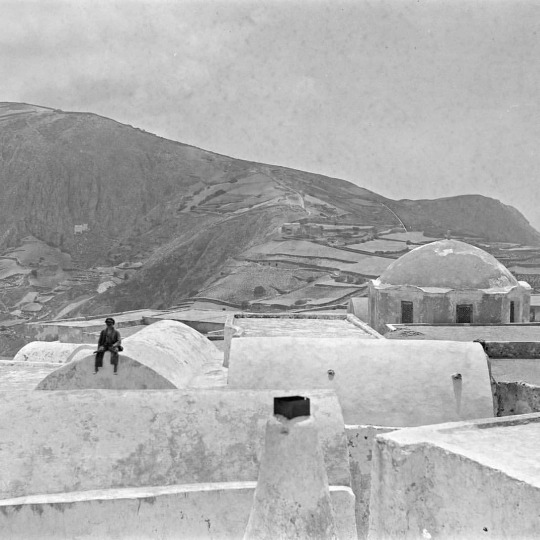
Sigfried Giedion, Residential Settlement, Santorini, 1933. "Sigfried Giedion (1888, Prague – 10 April 1968, Zürich) was a Bohemian-born Swiss historian and critic of architecture. His ideas and books, Space, Time and Architecture, and Mechanization Takes Command, had an important conceptual influence on the members of the Independent Group at the Institute of Contemporary Arts in the 1950s. Giedion was a pupil of Heinrich Wölfflin. He was the first secretary-general of the Congrès International d'Architecture Moderne. He also taught at the Massachusetts Institute of Technology and Harvard University. In Space, Time & Architecture, Giedion wrote an influential standard history of modern architecture, while Mechanization Takes Command established a new kind of historiography." https://www.instagram.com/p/CFkjZLvAMFG/?igshid=coez99hlvhim
119 notes
·
View notes